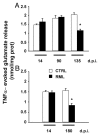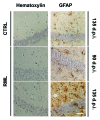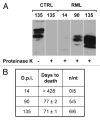Astrocyte signaling and neurodegeneration: new insights into CNS disorders
- PMID: 23093800
- PMCID: PMC3609047
- DOI: 10.4161/pri.22512
Astrocyte signaling and neurodegeneration: new insights into CNS disorders
Abstract
Growing evidence indicates that astrocytes cannot be just considered as passive supportive cells deputed to preserve neuronal activity and survival, but rather they are involved in a striking number of active functions that are critical to the performance of the central nervous system (CNS). As a consequence, it is becoming more and more evident that the peculiar properties of these cells can actively contribute to the extraordinary functional complexity of the brain and spinal cord. This new perception of the functioning of the CNS opens up a wide range of new possibilities to interpret various physiological and pathological events, and moves the focus beyond the neuronal compartment toward astrocyte-neuron interactions. With this in mind, here we provide a synopsis of the activities astrocytes perform in normal conditions, and we try to discuss what goes wrong with these cells in specific pathological conditions, such as Alzheimer Disease, prion diseases and amyotrophic lateral sclerosis.
Keywords: Alzheimer disease; Amyotrophic Lateral Sclerosis; Ca2+; astrocytes; glutamate; prion diseases.
Figures



Similar articles
-
Disruption of the astrocytic TNFR1-GDNF axis accelerates motor neuron degeneration and disease progression in amyotrophic lateral sclerosis.Hum Mol Genet. 2016 Jul 15;25(14):3080-3095. doi: 10.1093/hmg/ddw161. Epub 2016 Jun 10. Hum Mol Genet. 2016. PMID: 27288458
-
Copper homeostasis and neurodegenerative disorders (Alzheimer's, prion, and Parkinson's diseases and amyotrophic lateral sclerosis).Chem Rev. 2006 Jun;106(6):1995-2044. doi: 10.1021/cr040410w. Chem Rev. 2006. PMID: 16771441 Review. No abstract available.
-
Role and Therapeutic Potential of Astrocytes in Amyotrophic Lateral Sclerosis.Curr Pharm Des. 2017;23(33):5010-5021. doi: 10.2174/1381612823666170622095802. Curr Pharm Des. 2017. PMID: 28641533 Free PMC article. Review.
-
Astrocyte-derived Jagged-1 mitigates deleterious Notch signaling in amyotrophic lateral sclerosis.Neurobiol Dis. 2018 Nov;119:26-40. doi: 10.1016/j.nbd.2018.07.012. Epub 2018 Jul 26. Neurobiol Dis. 2018. PMID: 30010003
-
Analysis of the hippocampal proteome in ME7 prion disease reveals a predominant astrocytic signature and highlights the brain-restricted production of clusterin in chronic neurodegeneration.J Biol Chem. 2014 Feb 14;289(7):4532-45. doi: 10.1074/jbc.M113.502690. Epub 2013 Dec 23. J Biol Chem. 2014. PMID: 24366862 Free PMC article.
Cited by
-
Toll-like receptor 4 activation enhances Orai1-mediated calcium signal promoting cytokine production in spinal astrocytes.Cell Calcium. 2022 Jul;105:102619. doi: 10.1016/j.ceca.2022.102619. Epub 2022 Jun 25. Cell Calcium. 2022. PMID: 35780680 Free PMC article.
-
Porcine Astrocytes and Their Relevance for Translational Neurotrauma Research.Biomedicines. 2023 Aug 26;11(9):2388. doi: 10.3390/biomedicines11092388. Biomedicines. 2023. PMID: 37760829 Free PMC article. Review.
-
Perispinal etanercept for post-stroke neurological and cognitive dysfunction: scientific rationale and current evidence.CNS Drugs. 2014 Aug;28(8):679-97. doi: 10.1007/s40263-014-0174-2. CNS Drugs. 2014. PMID: 24861337 Free PMC article.
-
Multifactorial Gene Therapy Enhancing the Glutamate Uptake System and Reducing Oxidative Stress Delays Symptom Onset and Prolongs Survival in the SOD1-G93A ALS Mouse Model.J Mol Neurosci. 2016 Jan;58(1):46-58. doi: 10.1007/s12031-015-0695-2. Epub 2015 Dec 21. J Mol Neurosci. 2016. PMID: 26691332
-
Astrocyte Dysfunction Induced by Alcohol in Females but Not Males.Brain Pathol. 2016 Jul;26(4):433-51. doi: 10.1111/bpa.12276. Epub 2015 Jul 14. Brain Pathol. 2016. PMID: 26088166 Free PMC article.
References
-
- Tower DB, Young OM. The activities of butyrylcholinesterase and carbonic anhydrase, the rate of anaerobic glycolysis, and the question of a constant density of glial cells in cerebral cortices of various mammalian species from mouse to whale. J Neurochem. 1973;20:269–78. doi: 10.1111/j.1471-4159.1973.tb12126.x. - DOI - PubMed
Publication types
MeSH terms
Grants and funding
LinkOut - more resources
Full Text Sources
Other Literature Sources
Medical
Research Materials
Miscellaneous
